Teachers Statistics And Facts (2025)

Updated · Jun 26, 2025

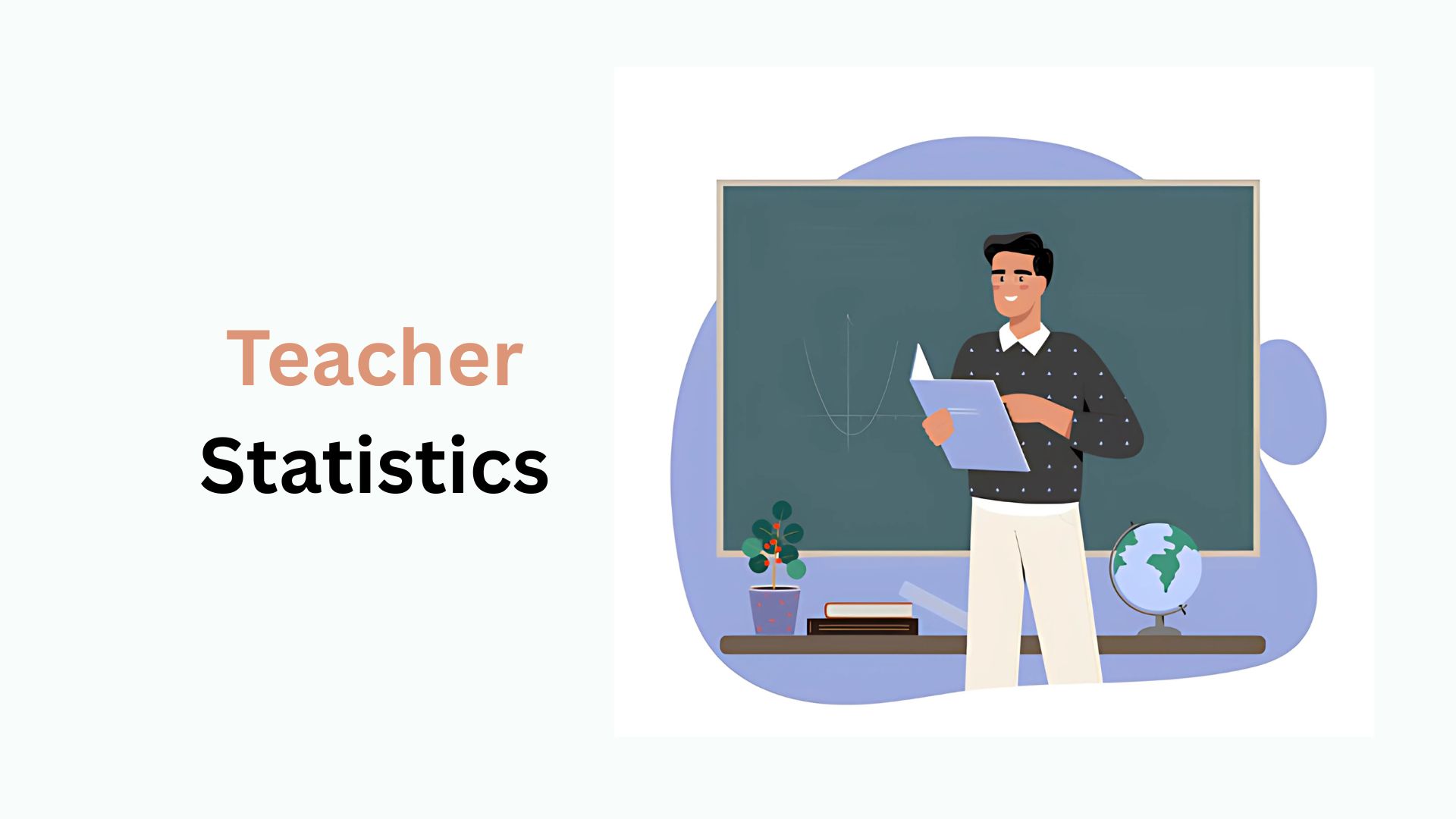
WHAT WE HAVE ON THIS PAGE
- Introduction
- Editor’s Choice
- General Teacher Statistics
- Facts About Teachers
- Teachers Statistics By Elementary And Secondary Schools U.S.
- Top EdTech Tools Used In K-12 Schools
- Teachers Statistics With The Minimum Required Qualification By Region And Level
- Teacher Registration Statistics
- Elementary And Secondary Teachers’ Statistics
- Pupil And Teacher Ratios In Elementary And Secondary Schools, By Control Of School
- New Teacher Hires Statistics By Control Of School
- Teachers Earning Statistics
- Teacher’s Statutory Salary Statistics By Experience Level, 2024
- Teacher Statistics By Age Group
- Global Teacher Hires Statistics By Region
- Teacher Time Spent Statistics By Country
- Teacher Shortage Statistics
- Teacher Statistics By Teachers’ Impact On Students
- Teacher Training Statistics
- Teachers Burnout Statistics
- Teachers Workload Statistics
- Teacher Statistics By Challenges
- Strategies For Teacher Collaboration In 2024
- Conclusion
Introduction
Teacher Statistics: Teachers are very important because they help shape the future by educating young people. The teaching profession faces many challenges and opportunities that affect how teachers teach and support their students. As the demand for quality education increases, many schools are using technology in classrooms to improve learning.
It is important to understand what teachers are facing today so that we can create better policies that help them and improve education for all students. This article examines key statistics, trends, and insights about the teaching profession in 2024 and highlights the need to support teachers in their efforts to promote learning and growth.
Editor’s Choice
- Teacher Statistics show that in 2024, the global teacher shortage will affect many countries. An estimated 69 million teachers are needed worldwide to meet education demands, especially in low-income areas.
- The average teacher-to-student ratio in developed countries is approximately 1:14, while in developing nations, it can be as high as 1:40 or more.
- In primary education, women will still be dominating the teaching profession, making up about 70% of the workforce globally.
- As of 2024, the average annual salary of public school teachers in the United States of America will remain between USD 50,000 and USD 70,000.
- Approximately 8% to 10% of teachers in the U.S. leave the profession each year due to burnout, low pay, and lack of administrative support.
- Meanwhile, Teachers in developed countries work an average of 50 to 55 hours per week, including time spent on lesson planning, grading, and extracurricular activities.
- Teacher Statistics further states that in 2024, governments worldwide allocated an estimated USD 30 billion for professional development.
- Around 85% of schools globally have incorporated technology into their teaching methods, such as online platforms, tablets, and virtual classrooms.
- In contrast, in the U.S., about 20% of public school teachers identify as non-white in recent years.
- On average, global educational spending will reach almost USD 4.9 trillion by the end of 2024.
General Teacher Statistics
- As mentioned in Teacher Statistics, in 2024, over 60% of teachers don’t want their children to become teachers.
- Over the last 28 years, American teachers’ weekly pay has only gone up by USD 29.
- In 28 states, teachers earn less than 80 cents for every dollar that people with similar college educations make.
- This pay gap, or “wage penalty”, will range from 2.4% in Rhode Island to 35.9% in Colorado in 2024.
- As of 2023, the number of teachers who are “very satisfied” with their jobs has almost doubled, reaching 20%.
- At the same time, around 44% of teachers have already quit their jobs.
- Teacher Statistics from 2022 to 2023 show that over the next ten years, there will be more than 109,000 job openings each year for Kindergarten and elementary school teachers.
- A report by the National Council on Teacher Equality shows that teacher mentorship jobs will be the best way to earn extra money in 2024.
- In recent years, out of 140 districts across the country, 42% of school districts have asked for teachers to have two or more years of mentoring.
- A teacher with a bachelor’s degree earns USD 4,400, and a teacher with a master’s degree who has been teaching for ten years earns USD 5,500.
Facts About Teachers
- World Teachers’ Day is celebrated on October 5th each year.
- There will be a 7% increase in jobs for Kindergarten and elementary teachers by the end of 2030, resulting in 124,300 teacher vacancies.
- Meanwhile, the total number of high school teachers will increase by 8%, creating 77,400 new jobs in the future.
- Based on the Career Explorer report, 60% of teachers said they are happy with their jobs, while 36% are not.
- More than half of K-12 teachers have master’s degrees, accounting for 51% of all teachers.
- 75% of teachers have experienced health problems related to stress.
- In recent years, most people around the world, about 89% of teachers, agreed that teaching is a difficult job.
- Teacher Statistics estimated that in previous years, burnout rates were high because three out of four teachers had to take on extra duties due to staff shortages.
Teachers Statistics By Elementary And Secondary Schools U.S.
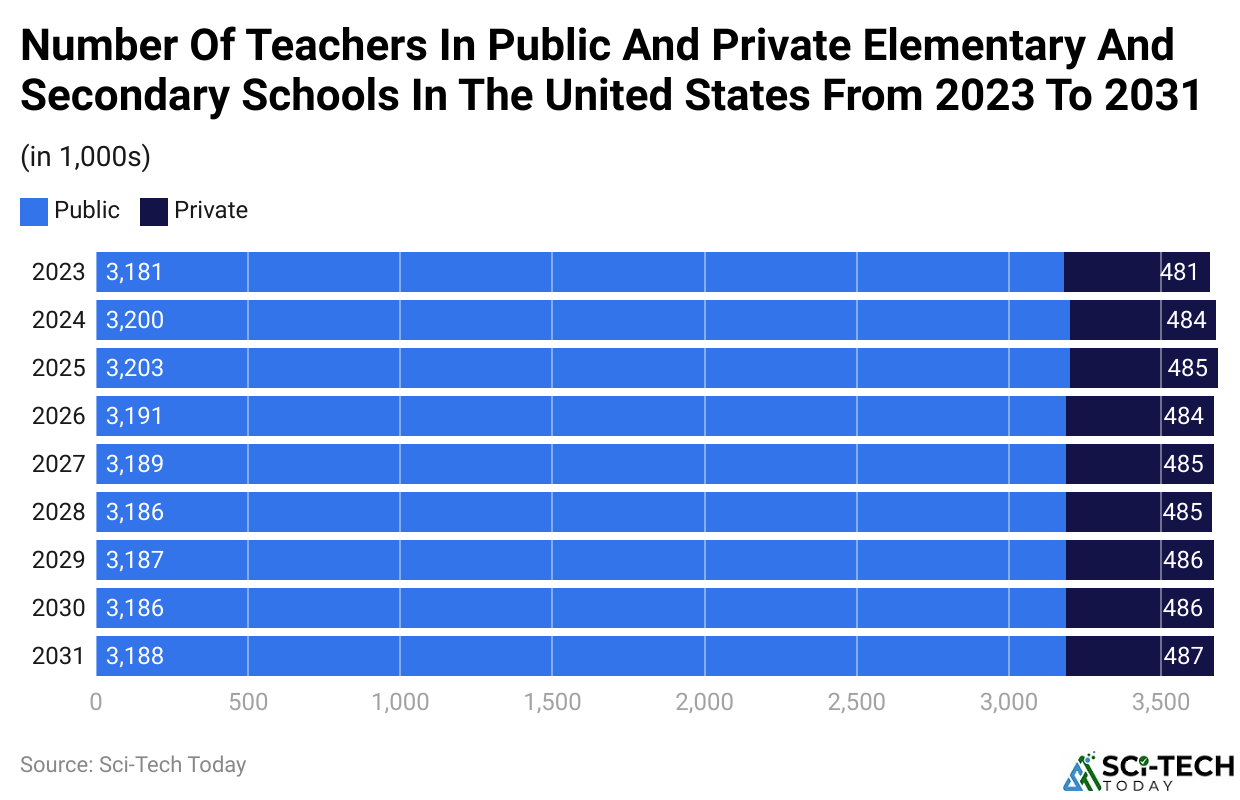 (Reference: statista.com)
(Reference: statista.com)
- In 2024, around 3,200K teachers worked in public elementary and secondary schools, while 484K teachers worked in public schools in the United States.
- Similarly, by 2031, the total number of teachers in public and private elementary and secondary schools will be around 3,188K and 487 K.
Top EdTech Tools Used In K-12 Schools
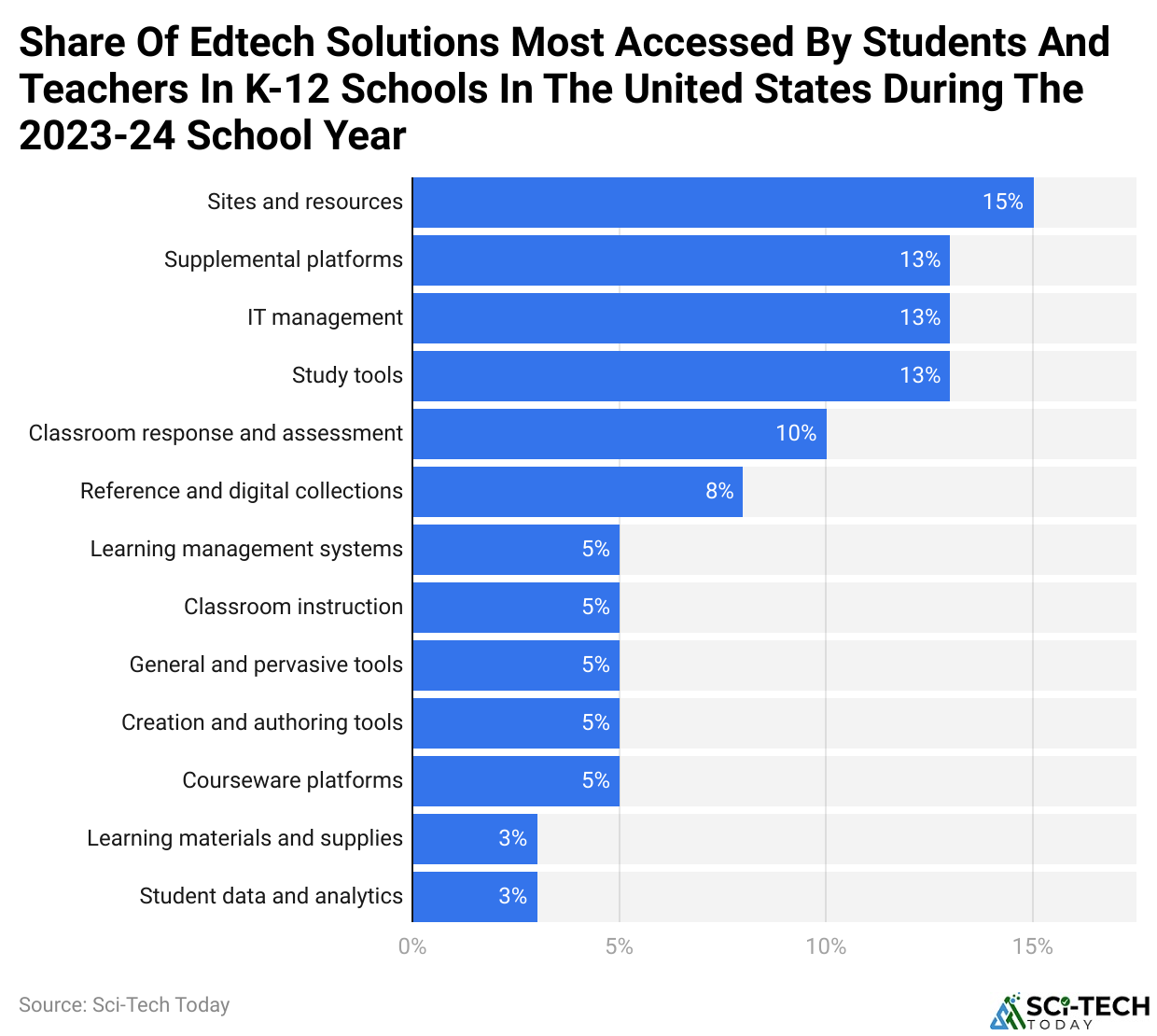 (Reference: statista.com)
(Reference: statista.com)
- Teacher Statistics further mentioned that in the 2023-24 school year, 15% of K-12 students and teachers in the U.S. used sites and resources.
- Besides, at the same time, the share of edtech solutions most accessed by students and teachers in K-12 schools are supplemental platforms (13%), I.T. management (13%), study tools (13%), classroom management and assessment (10%), reference and digital collections (8%), learning management system (5%), classroom instruction (5%), general and pervasive tools (5%), creation and authoring tools (5%), courseware platforms (5%), learning materials and supplies (3%) and student data and analytics (3%).
Teachers Statistics With The Minimum Required Qualification By Region And Level
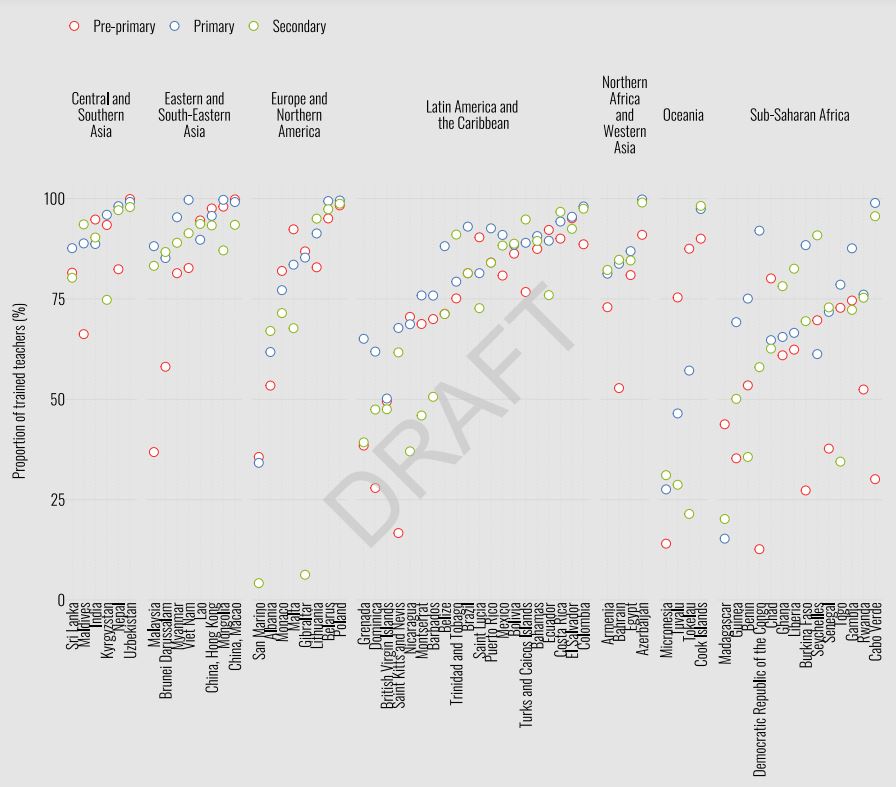 (Source: tcg.uis.unesco.org)
(Source: tcg.uis.unesco.org)
- In 2024, the proportion of trained teachers in North America, Europe, Latin America, and the Caribbean will be approximately 65%.
Furthermore, other regional analyses of 2024 are stated in the table below:
| Region | Pre-Primary | Primary | Secondary |
| North America | 95% (bachelor’s degree) | 98% (bachelor’s) | 95% (bachelor’s or master’s) |
| Europe | 93% (diploma or higher) | 97% (bachelor’s) | 94 to 96% (bachelor’s or master’s) |
| Sub-Saharan Africa | 55% (certificate or diploma) | 68% (diploma or bachelor’s) | 60% (bachelor’s) |
| Asia | 90-95% (East Asia) and 65% (South Asia) | 95% (East Asia) and 70% (South Asia) | 90-95% (East Asia) and 65-70% (South Asia) |
| Latin America | – | 85% | 80% |
Teacher Registration Statistics
- Teacher Statistics indicates that in Q2 2024, the global teacher registration rate reached approximately 88%, indicating that most educators are adhering to local and national registration requirements.
The table below elaborates on the regional breakdown of teacher registration rates in the same period.
| Region | Registration Rate |
| North America | The U.S. and Canada (95%) |
| Europe | Overall (93%) Finland & Germany (98%) |
| Asia | East Asia: Japan & South Korea (92%) South Asia (85%) |
| Sub-Saharan Africa | Overall (68%) South Africa (80%) |
| Latin America and the Caribbean | 78% |
| Middle East and North Africa | 75% |
Elementary And Secondary Teachers’ Statistics
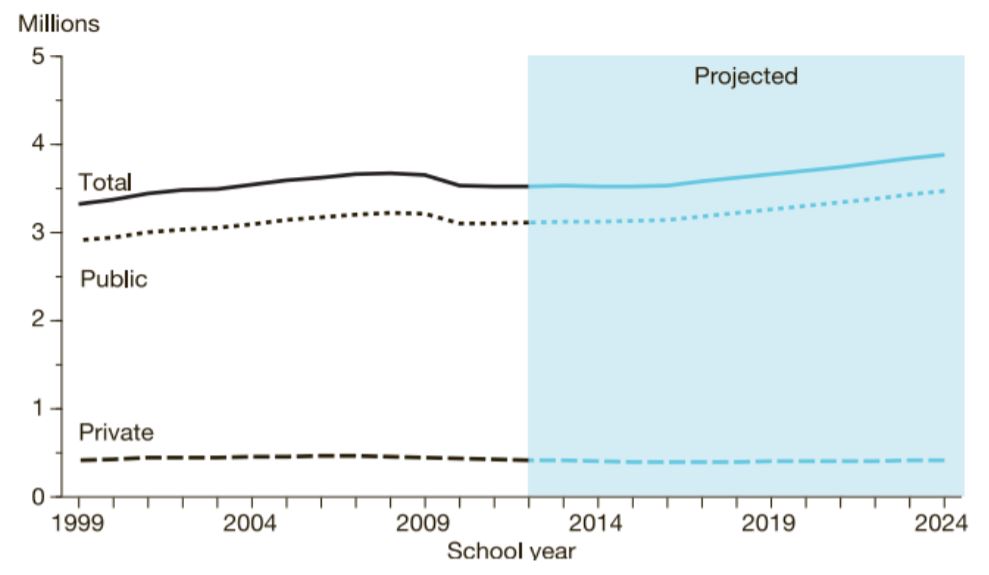 (Source: nces.ed.gov)
(Source: nces.ed.gov)
- As per the Teachers Statistics, the total number of elementary and secondary teachers grew by 6% from 1999 to 2012.
- Meanwhile, it is expected to grow by 10% from 2012 to 2024.
- On the other hand, the total number of teachers in public elementary and secondary schools grew by 7% from 1999 to 2012 and will grow by 11% between 2012 and 2024.
Pupil And Teacher Ratios In Elementary And Secondary Schools, By Control Of School
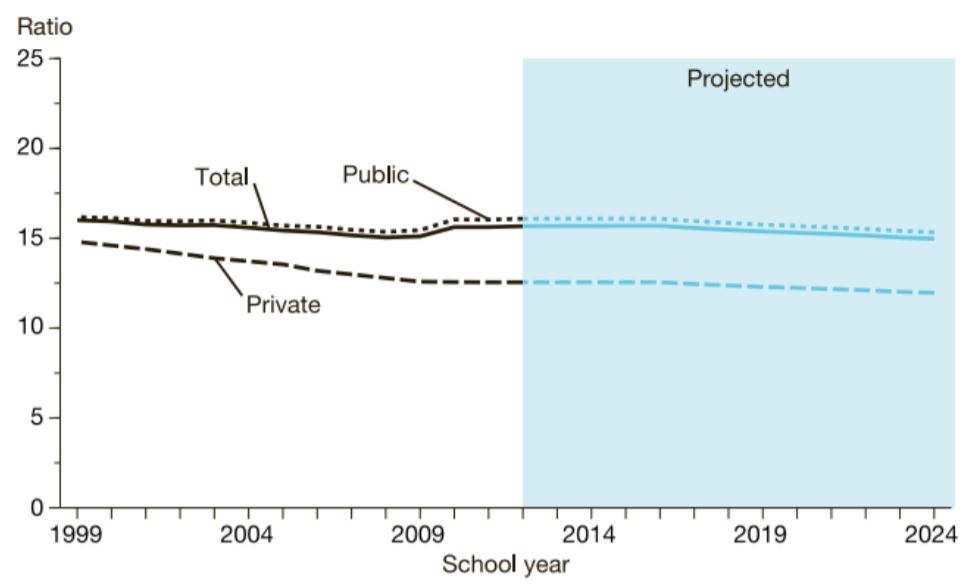 (Source: nces.ed.gov)
(Source: nces.ed.gov)
- The pupil-to-teacher ratio in elementary and secondary schools went down from 15.9 to 15.6 between 1999 and 2012.
- Teacher Statistics further states that, based on school control, it will drop further to 14.9 in 2024.
- In contrast, the teacher ratio in public schools decreased from 16.1 in 1999 to 16.0 in 2012 and will be 15.3 by the end of 2024.
- Similarly, in private schools, the pupil-to-teacher ratio went down from 14.7 to 12.5 (between 1999 and 2012) and is estimated to drop further to 11.9 in 2024.
New Teacher Hires Statistics By Control Of School
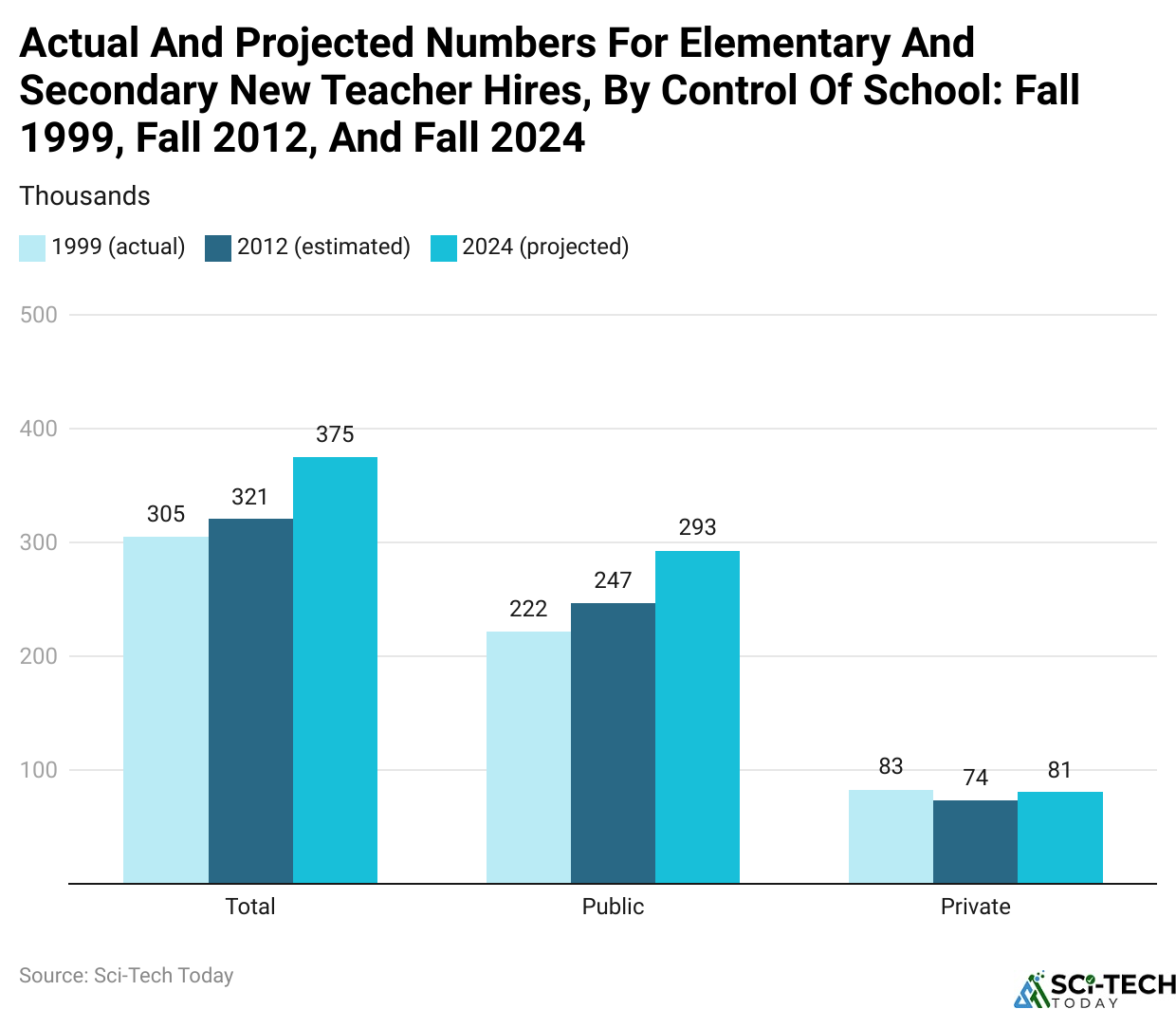 (Reference: nces.ed.gov)
(Reference: nces.ed.gov)
- Teachers Statistics also show that the total number of new teachers hired is expected to grow by 17% from 2012 to 2024, reaching 375,000.
- At the same time, in public schools, the number of new.
- Teacher hires will increase by 19%, resulting in 293,000.
- Moreover, in private schools, new teacher hires are estimated to reach 10% growth, accounting for 81,000.
Teachers Earning Statistics
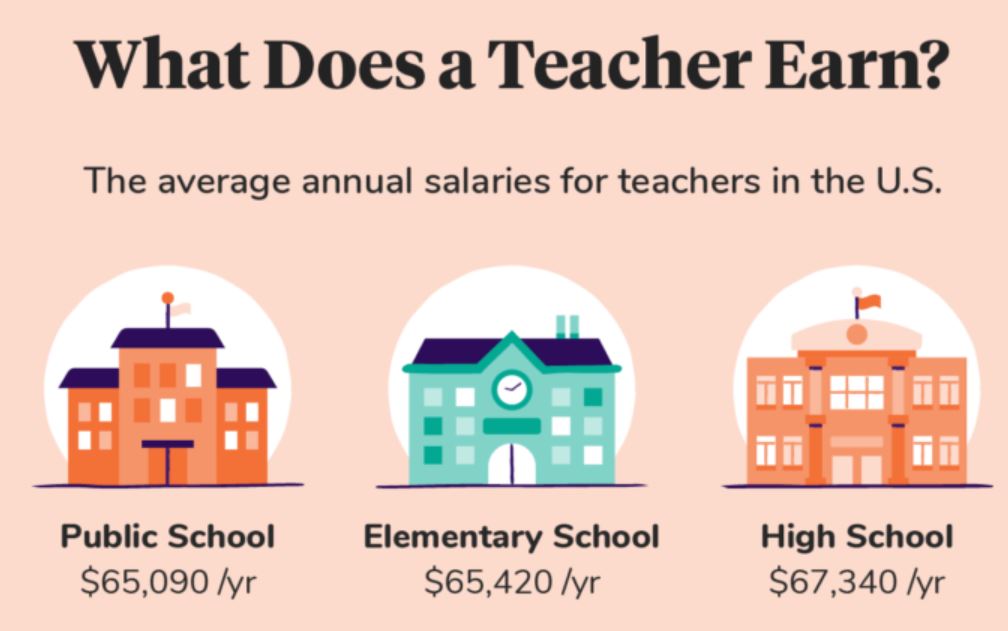 (Source: enterpriseappstoday.com)
(Source: enterpriseappstoday.com)
- In 2023, a public school teacher in the U.S. earns about USD 65,090 a year.
- Meanwhile, high school teachers earn USD 67,340, and elementary teachers earn USD 465,420.
- On the other hand, public school teachers earn 30% more money than private school teachers.
Teacher’s Statutory Salary Statistics By Experience Level, 2024
| Country (USD) |
Top Scale Salary | Starting Salary | After 10 Years | After 15 Years | Top Scale Salary | Starting Salary | After 10 Years | After 15 Years | Top Scale Salary | Starting Salary | After 10 Years | After 15 Years |
| Pre-Primary Education | Primary Education | Upper Secondary Education | ||||||||||
| Australia | 77 028 | 47 981 | 68710 | 68889 | 75 486 | 47 991 | 67949 | 69 513 | 75603 | 47 990 | 67 818 | 69369 |
| Austria | – | – | – | – | 86 526 | 49 646 | 52625 | 58910 | 102120 | 49 646 | 59852 | 61 854 |
| Canada | – | – | – | – | 72 734 | 42 157 | 69819 | 72 734 | 72 734 | 42 157 | 69819 | 72,734 |
| Colombia | 49 078 | 23 401 | 42677 | 42 677 | 49 078 | 23 401 | 42677 | 42677 | 49,078 | 23 401 | 42677 | 42,677 |
| Chile | 47 335 | 25 575 | 31 562 | 38394 | 47 335 | 25 575 | 31 562 | 38394 | 49 077 | 26 446 | 32723 | 39 729 |
| Costa Rica | 37 128 | 24 363 | 28618 | 30745 | 37 498 | 24 604 | 28902 | 31 051 | 38 653 | 25 355 | 29788 | 32004 |
| Denmark | 52 261 | 46 552 | 52 261 | 52 261 | 61 473 | 53 364 | 59294 | 61 473 | 65 555 | 50 444 | 65 555 | 65 555 |
| England | 55 726 | 34 732 | – | 55 726 | 55 726 | 34 732 | – | 55 726 | 55 726 | 34 732 | – | 55 726 |
| European Union (25 countries) | 53 626 | 32 541 | 39061 | 42586 | 58 742 | 35 175 | 42682 | 46894 | 63 474 | 36 985 | 45986 | 50082 |
| Finland | 35 955 | 32 664 | 35 616 | 35 955 | 48 642 | 37 407 | 42883 | 45888 | 56 380 | 42 191 | 50661 | 53 189 |
| France | 58 751 | 34,611.0 | 38 651 | 40683 | 58 751 | 34 611 | 38 651 | 40683 | 62 169 | 37 720 | 41 760 | 43 792 |
| Greece | 40 213 | 20 387 | 24793 | 26996 | 40 213 | 20 387 | 24793 | 26996 | 40 213 | 20 387 | 24793 | 26996 |
| Hungary | 27 597 | 16 137 | 18 173 | 19,520 | 27 597 | 16 137 | 18 173 | 19520 | 30 663 | 16 137 | 20193 | 21 689 |
| Italy | 48 015 | 32 981 | 36160 | 39584 | 48 015 | 32 981 | 36160 | 39584 | 55 106 | 35 447 | 40084 | 44,235 |
| Ireland | – | – | – | – | 70 244 | 36 281 | 50286 | 60902 | 70 840 | 36 281 | 50286 | 61 498 |
| Israel | 65 314 | 26 613 | 34865 | 37 814 | 54 695 | 23 561 | 29864 | 33606 | 56 501 | 27 876 | 32 531 | 39 321 |
| Japan | – | – | – | – | 58 562 | 28 611 | 40532 | 47349 | 60 106 | 28 611 | 40532 | 47 349 |
| Korea | 94 489 | 33 615 | 50780 | 59346 | 94 489 | 33 615 | 50780 | 59346 | 94 549 | 33 675 | 50840 | 59406 |
| Luxembourg | 126576 | 71 647 | 92663 | 104604 | 126576 | 71 647 | 92663 | 104604 | 141 144 | 81 200 | 101500 | 112008 |
| Latvia | – | 17 902 | – | – | – | 17 039 | – | – | – | 17 039 | – | – |
| Lithuania | 43 195 | 33 027 | 34102 | 37 946 | 43 195 | 33 027 | 34102 | 37 946 | 43 195 | 33 027 | 34 102 | 37 946 |
| Mexico | 42 694 | 21 802 | 27294 | 34 047 | 42 694 | 21 802 | 27294 | 34 047 | 62 681 | 51 010 | 58 746 | 62 681 |
| New Zealand | – | – | – | – | 56 125 | 34 890 | 56 125 | 56 125 | 56 125 | 34 890 | 56 125 | 56 125 |
| Norway | 48 588 | 39 337 | 47854 | 47 854 | 55 489 | 43 108 | 51 727 | 51 727 | 62 688 | 51 096 | 56 557 | 56 557 |
| Netherlands | 99 715 | 48 805 | 69624 | 79 300 | 99 715 | 48 805 | 69624 | 79 300 | 99 717 | 48 662 | 73 959 | 84 862 |
| Portugal | 73 978 | 34 311 | 41 736 | 44 277 | 73 978 | 34 311 | 41 736 | 44 277 | 73 978 | 34 311 | 41 736 | 44 277 |
| Poland | 32 778 | 19,235 | 25766 | 31 447 | 32 778 | 19 235 | 25766 | 31 447 | 32 778 | 19 235 | 25 766 | 31 447 |
| Spain | 63 910 | 44 650 | 48 516 | 51 715 | 63 910 | 44 650 | 48 516 | 51 715 | 71 235 | 49 905 | 54 243 | 57 758 |
| Switzerland | 86 338 | 56 429 | 70367 | – | 92 592 | 60 874 | 75 791 | – | 117 001 | 76 318 | 98 468 | – |
| Slovenia | 53 504 | 31 187 | 36876 | 46 343 | 57 595 | 31 187 | 38 213 | 48 062 | 57 595 | 31 187 | 38 213 | 48 062 |
| Sweden | 49 457 | 42 374 | 44430 | 45 132 | 57 042 | 43 001 | 47 451 | 49 583 | 59 048 | 45 132 | 49 232 | 51 275 |
| Scotland | 55 096 | 43 895 | 55096 | 55 096 | 55 096 | 43 895 | 55096 | 55 096 | 55 096 | 43 895 | 55 096 | 55 096 |
| Türkiye | 50 489 | 46 333 | 47 691 | 47 063 | 50 489 | 46 333 | 47 691 | 47 063 | 50 978 | 46 822 | 48 180 | 47 551 |
| United States | 76 985 | 45 931 | 50953 | 68 905 | 78 190 | 44 992 | 61054 | 66 251 | 75 988 | 48 187 | 63 026 | 69 641 |
| OECD | 57 118 | 34 563 | 43063 | 45 981 | 61 075 | 36 367 | 46782 | 49 968 | 65 658 | 39 274 | 50 841 | 53 456 |
| Romania | 39 721 | 23 300 | 27 792 | 29 969 | 39 721 | 23 300 | 27 792 | 29 969 | 39 721 | 23 300 | 27 792 | 29 969 |
Teacher Statistics By Age Group
- In the United States of America, the average age of a teacher has been about 42 years in recent years.
- The largest share of teachers accounts for 56.9% of those aged between 30 to 49 years.
| Age (years) | Teachers share |
| Below 30 | 15% |
| 30 to 49 | 56.9% |
| 50 to 54 | 11.6% |
| 55 and above | 16.5% |
By Gender
- According to Teacher Statistics, in 2024, around 74.3% of American teachers will be female, and males will account for 25.7%.
Furthermore, the other share of teachers by gender in 2024 is as:
| Types of School | Male | Female |
| Pre-Primary Education | 5% | 95% |
| Primary Education | 15% | 85% |
| Secondary Education | 43% | 57% |
| Public Schools | 24% | 76% |
| Private Schools | 34% | 66% |
| Charter Schools | 35% | 65% |
| Special Education | 23% | 77% |
By Race/Ethnicity
- In the U.S., around 79.3% of teachers are white or non-Hispanic, while other teachers’ shares by race in recent years are stated below.
| Ethnicity | Teacher’s Share |
| White | 79.3% |
| Hispanic | 9.3% |
| Black or African American | 6.7% |
| Asian | 2.1% |
| Two or African American | 1.8% |
| Native American/Alaska Native | 0.5% |
| Native Hawaiian/Pacific Islander | 0.2% |
Global Teacher Hires Statistics By Region
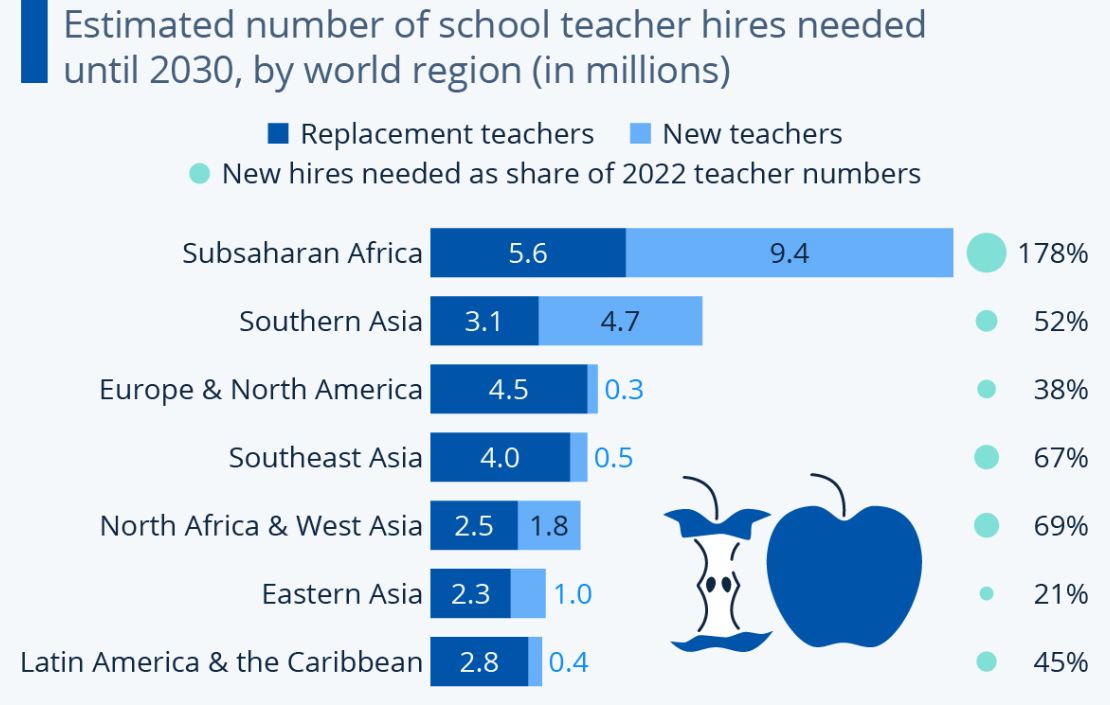 (Source: statista.com)
(Source: statista.com)
- A report published by UNESCO shows that in Southern Asia, total teacher hires are 178% of the 2022 teacher count.
- Meanwhile, by 2030, in this region, replacement teachers will number 5.6 million, and new teachers will number 9.4 million.
- Teacher Statistics also elaborated that by the end of 2030, around 4.7 million new teachers will be needed, and 3.1 million will need replacing. Still, only 52% of this need was met in Southern Asia in 2022.
The table below estimates the number of primary and secondary school teachers needed 2030 by other regions:
| Region | Replacement Teachers | New Teachers |
| Europe and North America | 4.5 million | 0.3 million |
| Southeast Asia | 4.0 million | 0.5 million |
| North Africa and West Asia | 2.5 million | 1.8 million |
| Eastern Asia | 2.3 million | 1.0 million |
| Latin America and the Caribbean | 2.8 million | 0.4 million |
Teacher Time Spent Statistics By Country
- Teacher Statistics further reports that the average weekly time spent by teachers in the U.S. will be up to 53 hours.
Furthermore, representations are detailed in the table below in 2024:
| Country | Average Weekly Hours | Teaching Hours | Preparation and Other Duties |
| United States | 53 | 22 | 31 |
| Canada | 50 | 25 | 25 |
| United Kingdom | 55 | 23 | 32 |
| Australia | 49 | 20 | 29 |
| Germany | 45 | 21 | 24 |
| Japan | 55 | 20 | 35 |
| South Korea | 48 | 23 | 25 |
| France | 41 | 26 | 15 |
| China | 47 | 25 | 22 |
| India | 40 | 20 | 20 |
Teacher Shortage Statistics
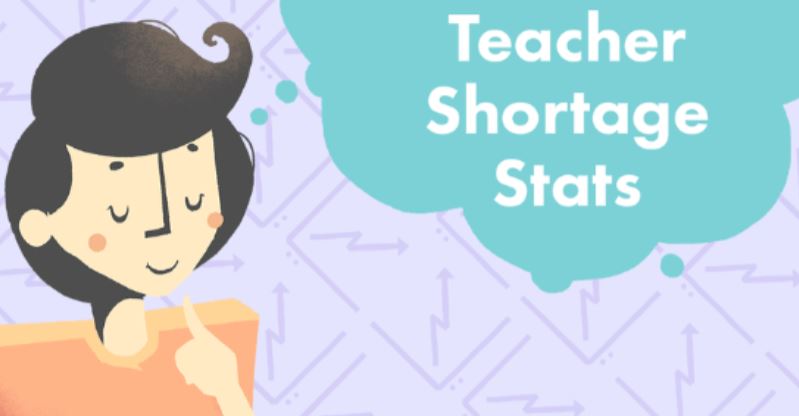
- As USA Today mentions, around 86% of public schools will find it difficult to hire enough teachers for their classrooms in 2024.
- However, schools in poor areas still lack teachers, but other districts improved, with understaffing reduced to 45% from 53% in 2023.
- In the next two years, almost 35% of teachers might leave their jobs.
- Around 35% of public schools are very worried about finding substitute teachers when needed.
- Teachers earn 23.5% less money compared to other people who graduated from college with similar qualifications.
- According to the U.S. Department of Education and the National Education Association, almost 45 states are expecting teacher shortages in three important subjects: special education, mathematics, and science.
- At least 30 states are also expecting an insufficient number of teachers in language arts, world languages, English as a second language (ESL), career and technical education, physical fitness, and social studies in 2024.
- In the academic year 2023 to 2024, nearly 37% of public schools will have at least one unfilled teacher position, and 45% will have at least one open non-teaching position.
By the Highest States of the U.S.
| States | Teachers Vacancy |
| California | 12,000+ |
| Texas | 9,000+ |
| Florida | 7,500+ |
| New York | 6,500+ |
| Arizona | 5,600+ |
| Nevada | 5,000+ |
| Georgia | 4,800+ |
| Illinois | 4,500+ |
| Pennsylvania | 4,200+ |
| North Carolina | 3,800+ |
By the Lowest States of the U.S.
| States | Teachers Vacancy |
| Massachusetts | 2,000 |
| Vermont | 600 |
| Connecticut | 1,500 |
| Rhode Island | 500 |
| New York | 5,000 |
| Minnesota | 1,800 |
| New Jersey | 2,500 |
| Hawaii | 1,000 |
| Maine | 700 |
| Washington | 3,000 |
Teacher Statistics By Teachers’ Impact On Students
- As per recent studies, a typical teacher will influence over 3,000 students during their career.
- Around 88% of people have claimed that their teachers had impacted their lives positively.
- Meanwhile, 87% of people would like to thank their teachers more for all the help and support they have given them.
- 83% of students accepted that a teacher helped them feel more confident and better about themselves.
- Teacher Statistics further showed that around 79% of students stated that their teachers had encouraged them to follow their dreams.
- In contrast, almost 75% of students think teachers are mentors and role models who guide and support them in their learning journey.
- 54% of students say a teacher has helped them during a hard time.
By Life as a Teacher
- As mentioned in Teacher Statistics, teachers spend about USD 750 each year on school supplies for their classrooms.
- In the U.S., teachers spend about 998 hours teaching in the classroom in 2024.
- During the same period, nearly 18% of teachers have second jobs during the school year, much higher than the 4.5% of U.S. workers.
- About 89% of people believe that being a teacher is a challenging task and requires a lot of effort.
Teacher Training Statistics
- Teacher Training Statistics in 2024 reports that approximately 85% of teachers worldwide have received some form of pre-service training.
- Based on the regional breakdown, about 95% of teachers in North America are trained, followed by Europe (92%), Sub-Saharan Africa (68%), and Asia (90%).
- As of 2024, around 40% of teachers globally participated in in-service training programs.
- In developed and developing countries, around 40% and 25% of teachers globally participated in in-service training programs, respectively.
- In teacher training programs, governments and organizations invested approximately USD 25 billion.
- 50% of teachers used online professional development courses for training purposes.
- Meanwhile, 94% of teachers are certified with the necessary training and have passed the required assessments.
- In contrast, only 60% of teachers in many low-income countries hold a formal certification.
- Teacher Statistics show that 30% of newly trained teachers will participate in mentorship programs in 2024.
- 45% of teachers receive subject-specific training in STEM fields (Science, Technology, Engineering, and Mathematics).
- By the end of 2025, 90% of teachers will receive formal training across the world.
Teachers Burnout Statistics
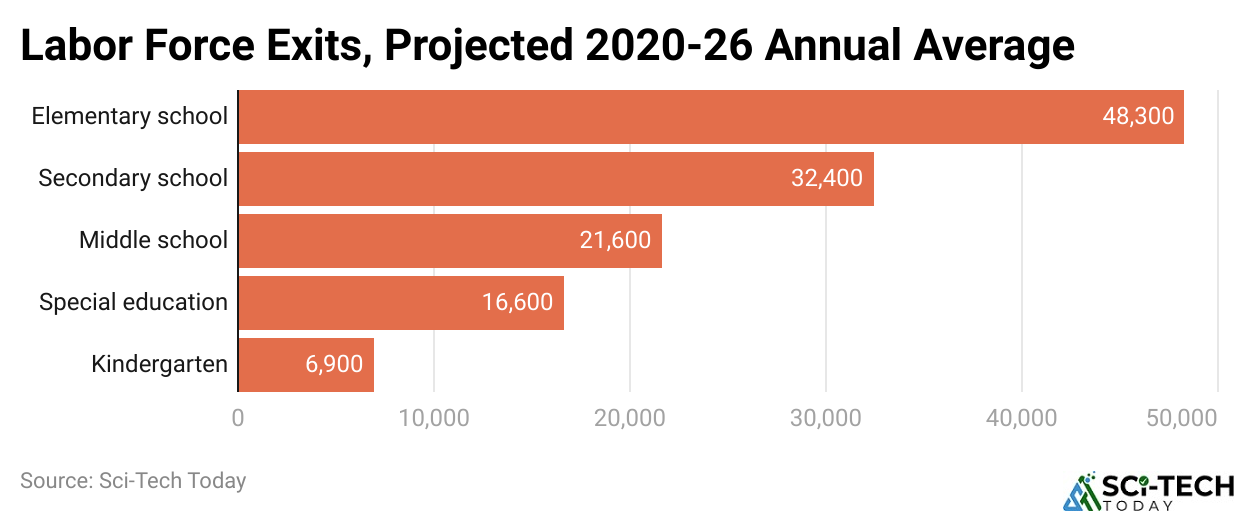 (Reference: thinkimpact.com)
(Reference: thinkimpact.com)
- In recent days, thousands of teachers have quit their jobs due to burnout. From 2020 to 2026, it is estimated that around 48,300 elementary school teachers will quit in the U.S.
- During the same period, the expected number of teachers quit their jobs in secondary school (32,400), middle school (21,600), special education (16,600), and Kindergarten (6,900).
Teachers Workload Statistics
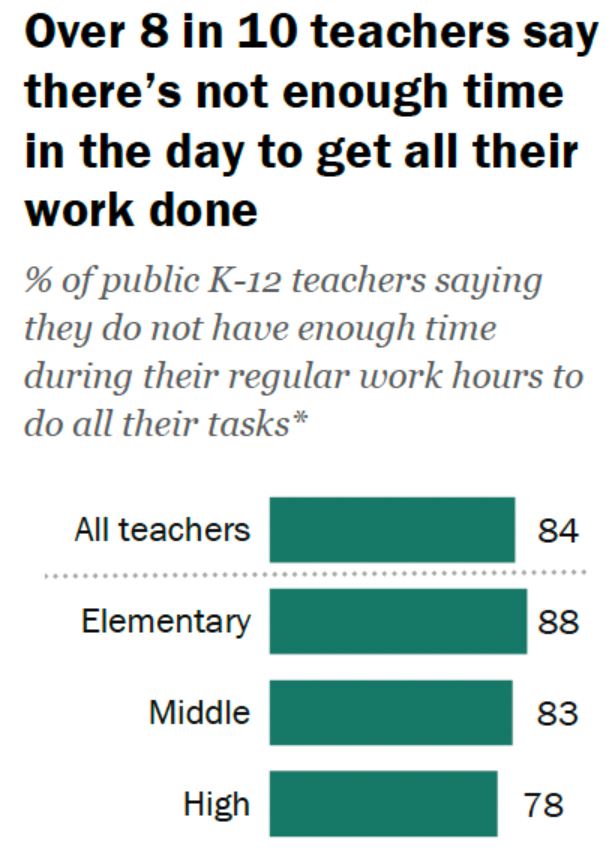 (Source: pewresearch.org)
(Source: pewresearch.org)
- Around 84% of teachers have claimed that they lack time during work hours for grading, planning, and emails, which is segmented into 88% (elementary school teachers), 83% (middle school teachers), and 78% (high school teachers).
- It becomes difficult for teachers to complete other chores during working hours, as 24% often have to do non-teaching tasks, like lunch duty or hallway monitoring.
| Reasons | Teachers major share | Teachers minor share |
| Having too much work | 81% | 17% |
| Often spend more time helping students outside the classroom | 22% | 50% |
| Performing non-teaching duties, such as hallways or lunch duty | 24% | 42% |
| Need to cover for another teacher’s class when they aren’t available | 16% | 35% |
- Teacher Statistics states that 70% of K-12 teachers remained very or somewhat understaffed, followed by 27% (neither understaffed nor overstaffed) and 2% (very/somewhat overstaffed).
Teacher Statistics By Challenges
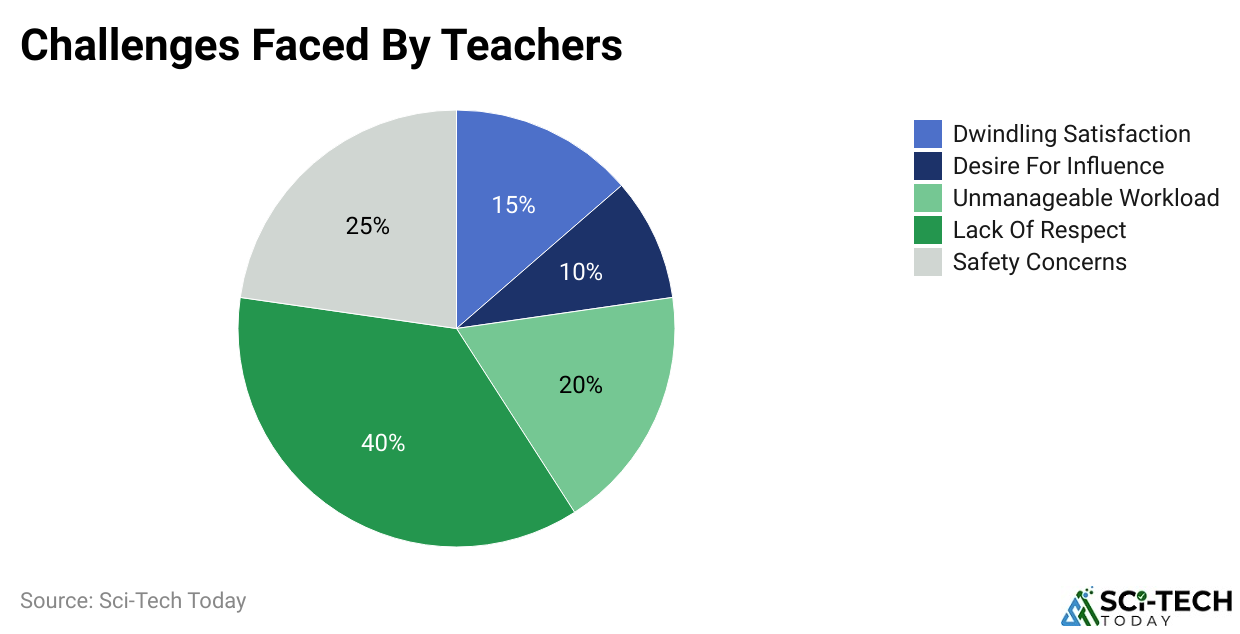 (Reference: airteachr.com.au)
(Reference: airteachr.com.au)
- A report analyzed by AirTeachr shows that the main challenge faced by teachers is a lack of respect, which accounts for 40% of them worldwide by the end of 2023.
- In addition, other challenges faced by teachers are safety concerns (25%), unmanageable workload (20%), dwindling satisfaction (15%), and desire for influence (10%).
Strategies For Teacher Collaboration In 2024
- 71% of teachers in schools using Professional Learning Communities (PLCs) reported improved student performance.
- Schools providing 3+ hours per week for collaborative planning see a 20% increase in student achievement.
- Teacher Statistics show that 65% of teachers who engage in peer observations feel more supported in their teaching.
- The usage of platforms like Google Classroom increased by 45% among teachers for collaborative projects.
- In 2024, schools with mentorship programs report a 25% higher retention rate of new teachers.
- Around 50% of teachers collaborating across subjects noted greater student engagement.
- Schools with defined collaborative goals saw a 30% improvement in overall teacher satisfaction.
- Collaborative efforts involving families lead to a 15% increase in student attendance.
Conclusion
Teachers are essential to the educational system, influencing the lives of students and shaping future generations. However, many problems can make their work harder. These problems include high workloads, the need for more teachers, and inconsistent support from schools.
As we look ahead, it is essential to recognize how crucial teachers are. We need to create policies that help meet their needs. This means investing in teacher training, reducing their workloads, and building a supportive environment. When we support teachers, we not only help them but also improve students’ education.
Sources
FAQ.
Teachers support learning by designing engaging lessons, providing instruction, giving helpful feedback, creating a positive classroom environment, and helping students develop critical thinking and problem-solving skills.
- Setting Clear Rules: Make sure all students understand the rules and expectations for behaviour.
- Creating a Positive Atmosphere: Foster a friendly and supportive environment by which students feel safe and encouraged.
- Addressing Disruptive Behavior: Use strategies to manage and correct any behaviour that disrupts learning.
It ensures a positive impact on students’ lives, helps students develop a love for learning, and often offers opportunities for professional growth and advancement.

Maitrayee, after completing her graduation in Electrical Engineering, transitioned into the world of writing following a series of technical roles. She specializes in technology and Artificial Intelligence, bringing her experience as an Academic Research Analyst and Freelance Writer, with a focus on education and healthcare under the Australian system. From an early age, writing and painting have been her passions, leading her to pursue a full-time career in writing. In addition to her professional endeavors, Maitrayee also manages a YouTube channel dedicated to cooking.









